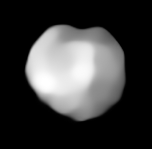89 Julia
 VLT-SPHERE image of Julia. The large crater Nonza, half the diameter of the asteroid, is centered on the upper left quadrant. | |
| Discovery | |
|---|---|
| Discovered by | Édouard Stephan |
| Discovery date | 6 August 1866 |
| Designations | |
| (89) Julia | |
| Pronunciation | /ˈdʒuːliə/[1] |
Named after | Julia of Corsica |
| Main belt | |
| Adjectives | Julian /ˈdʒuːliən/ |
| Orbital characteristics [2] | |
| Epoch 31 July 2016 (JD 2457600.5) | |
| Uncertainty parameter 0 | |
| Observation arc | 149.68 yr (54672 d) |
| Aphelion | 3.0202 AU (451.82 Gm) |
| Perihelion | 2.08017 AU (311.189 Gm) |
| 2.55016 AU (381.499 Gm) | |
| Eccentricity | 0.18430 |
| 4.07 yr (1487.5 d) | |
| 255.367° | |
| 0° 14m 31.272s / day | |
| Inclination | 16.128° |
| 311.563° | |
| 45.461° | |
| Physical characteristics | |
| Dimensions | c/a = 0.70±0.03[3] (89±2)×(80±1)×(62±3) km[4] |
| 140±3 km[4][3] 151±3 km[2] 148±8 km[5] | |
| Mass | (4.3±3.2)×1018 kg[3] (4.3±3.6)×1018 kg[4] (6.7±1.8)×1018 kg[5] |
Mean density | 3.0±2.2 g/cm3[3] 3.0±2.6 g/cm3[4] 4.0±1.3 g/cm3[5] |
| 11.388336±0.000001 h (0.4745 day)[4] | |
| 0.216 (calculated)[3] 0.1764±0.007[2] 0.176 [6] | |
| S | |
| 8.74 to 12.61[7] | |
| 6.60 | |
| 0.18" to 0.052" | |
89 Julia is a large main-belt asteroid that was discovered by French astronomer Édouard Stephan on 6 August 1866. This was first of his two asteroid discoveries; the other was 91 Aegina. 89 Julia is believed to be named after Saint Julia of Corsica. A stellar occultation by Julia was observed on 20 December 1985.
The spectrum of 89 Julia shows the signature of silicate rich minerals with possible indications of an abundant calcic clinopyroxene component. It is classified as an S-type asteroid. The asteroid has an estimated diameter of 151.4±3.1 km.[8] Photometry from the Oakley Observatory during 2006 produced a lightcurve that indicated a sidereal rotation period of 11.38±0.01 with an amplitude of 0.20±0.02 in magnitude.[9]
Nonza crater and Julian family
[edit]89 Julia is the parent body of the eponymous Julia family of asteroids. Observations of 89 Julia by the VLT's SPHERE instrument identified a 'highly probable' crater 70–80 km in diameter and 4.1±1.7 km deep in the southern hemisphere as the only visible possible source of the family.[10] The crater was named Nonza by the discoverers, referring to the commune on the island of Corsica where Saint Julia was born.[11] The excavated volume is on the order of 5,000 to 15000 km3. It is hypothesized an impact 30 to 120 million years ago by another body approximately 8 kilometers in diameter may have created the collisional family.
References
[edit]- ^ Noah Webster (1884) A Practical Dictionary of the English Language
- ^ a b c Yeomans, Donald K., "89 Julia", JPL Small-Body Database Browser, NASA Jet Propulsion Laboratory, retrieved 13 May 2016.
- ^ a b c d e P. Vernazza et al. (2021) VLT/SPHERE imaging survey of the largest main-belt asteroids: Final results and synthesis. Astronomy & Astrophysics 54, A56
- ^ a b c d e Vernazza et al. (August 2018) The impact crater at the origin of the Julia family detected with VLT/SPHERE?, Astronomy and Astrophysics 618, DOI: 10.1051/0004-6361/201833477
- ^ a b c Carry, B. (December 2012), "Density of asteroids", Planetary and Space Science, 73 (1): 98–118, arXiv:1203.4336, Bibcode:2012P&SS...73...98C, doi:10.1016/j.pss.2012.03.009. See Table 1.
- ^ Asteroid Data Sets Archived 2009-12-17 at the Wayback Machine
- ^ "AstDys (89) Julia Ephemerides". Department of Mathematics, University of Pisa, Italy. Retrieved 27 June 2010.
- ^ Birlan, Mirel; Barucci, Maria Antonietta; Vernazza, Pierre; Fulchignoni, Marcello; Binzel, Richard P.; Bus, Schelte J.; et al. (June 2004). "Near-IR spectroscopy of asteroids 21 Lutetia, 89 Julia, 140 Siwa, 2181 Fogelin and 5480 (1989YK8), potential targets for the Rosetta mission; remote observations campaign on IRTF". New Astronomy. 9 (5): 343–351. arXiv:astro-ph/0312638. Bibcode:2004NewA....9..343B. doi:10.1016/j.newast.2003.12.005.
- ^ Ditteon, Richard; Hawkins, Scot (September 2007), "Asteroid Lightcurve Analysis at the Oakley Observatory - October-November 2006", The Minor Planet Bulletin, 34 (3): 59–64, Bibcode:2007MPBu...34...59D, ISSN 1052-8091.
- ^ Vernazza, P.; Broz, M.; Drouard, A. "Astronomy & Astrophysics (A&A)". www.aanda.org. Retrieved 20 December 2019.
- ^ Vernazza, P. "ESO/VLT/SPHERE Survey of D>100km Asteroids : First Results" (PDF). USRA. Retrieved 20 December 2019.
External links
[edit]- 89 Julia at AstDyS-2, Asteroids—Dynamic Site
- 89 Julia at the JPL Small-Body Database
